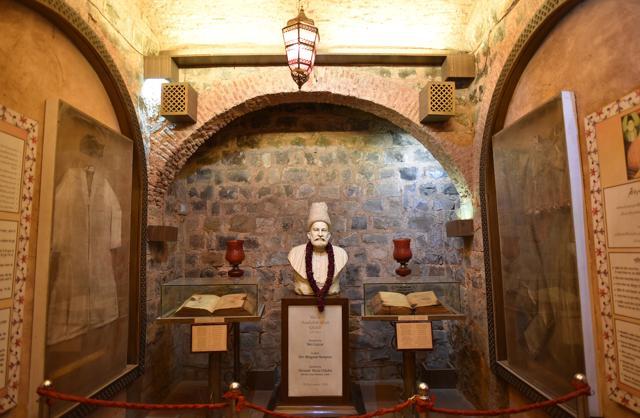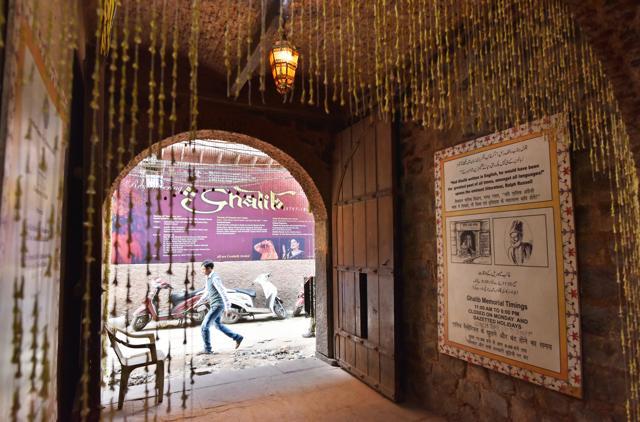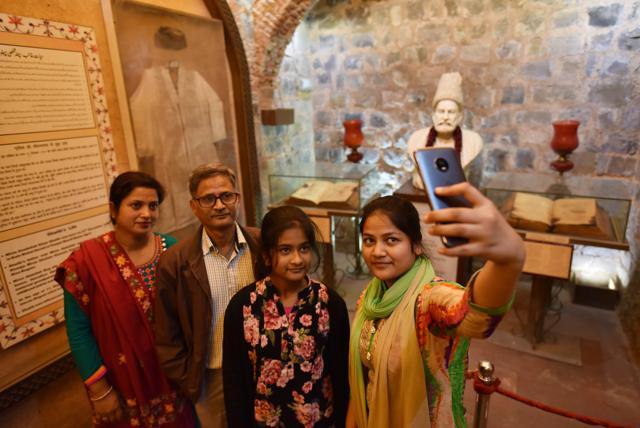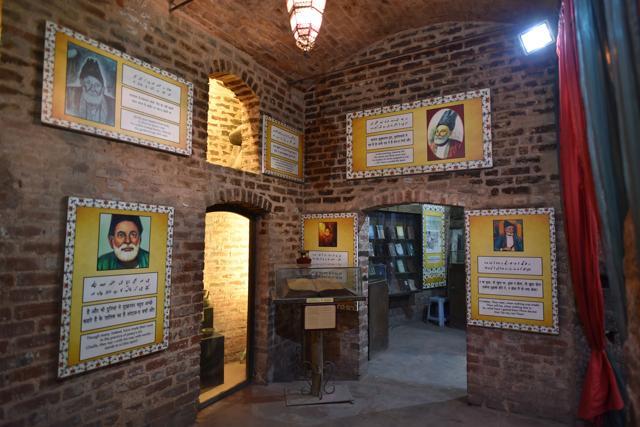Remembering Mirza Ghalib as he turns 220: ‘The world is the body, Delhi its soul’
Ghalib (the conqueror) was born as Asadullah Baig Khan on December 27, 1797 in Kala Mahal, Agra into a family descending from Aibak Turks who moved to Samarkand (modern-day Uzbekistan) after downfall of Seljuk kings. He came to Delhi when he was 13.
Sanjay Singh doesn’t know Urdu. But whenever his friends are in town, he makes sure they visit Mirza Ghalib’s haveli that stands down Gali Qasim Jaan in Chandni Chowk’s rundown neighbourhood of Ballimaran.

This Sunday too, Singh, 28, a graphic-designing student, accompanied his friend Dolan to the mansion, walking past old Delhi’s overcrowded streets along rows of optical shops. To their delight, the haveli was being decked up ahead of the poet’s 220th birth anniversary celebrations on Wednesday.
“All I know is Ghalib was a famous Urdu poet and this is the place where he lived,” says Singh, from Jodhpur and in Delhi for studies. For many like him, the mansion is like any other monument in the city.
Delhi’s poet
Now a heritage site, Ghalib ki Haveli is the place where the poet spent the last six years of his life till he died on February 15, 1869. Born in Agra on December 27, 1797, as Mirza Asadullah Baig Khan, who later used pen name ‘Ghalib’ (the conqueror), he migrated to Delhi where he lived for the rest of his life. It was during his stay in many rented houses, including the haveli, when Delhi was witness to the most turbulent times during the 1857 revolt, that he penned down couplets and anecdotes still populating the cultural landscape of the National Capital and beyond. Ghalib, it is said, wrote the Diwan-e-Ghalib (the collection of poems) at this haveli
For heritage lover Girish Srivastava, 60, a talk on Delhi is not possible without Ghalib. As he enters the haveli once again, Srivastava belts out a famous couplet by Ghalib on his love for Delhi
“Ik roz apni rooh se poocha, ki dilli kya hai, to yun jawab main keh gaye, yeh duniya mano jism hai aur dilli uski jaan (I asked my soul, ‘What is Delhi?’ It replied: ‘The world is the body, Delhi its soul”)
Nestled in a quiet corner on the left side of the crowded narrow alleys leading to the shrine of Sufi saint Hazrat Nizamuddin Auliya, southward of Old Delhi, lies the desolate tomb of Ghalib decked in white marble.
As groups of children play cricket and football in a nearby concrete lawn, a couple of admirers come and pay obeisance with flowers on the grave.
“I was passing by. I saw the board of this grave outside. So I thought I should see this too,” said Jai Kishan, a businessman from Mayur Vihar, who says he doesn’t know anything about the poet or the place.
A few metres from the grave, a plaque mentions Ghalib as “among the greatest poets of South Asia”.

Language no barrier
For those who don’t know Urdu , like Singh and his friend Dolan, Ghalib’s poetry in translation cannot but evoke a heady mix of love, beauty, intoxication and despair.
“His work becomes most relevant in this day and age because his non-conformity pushes us to question hierarchical structures of society,” says Dolan, 25, a history student at Jawaharlal University.
Others with deep knowledge of Urdu get swayed by his invincible grip on the language, which sets him apart.
“Ghalib touches a chord in everyone’s heart. There could be hardly anyone who, after reading Ghalib’s immortal verses, says his emotions were not touched,” says historian Rana Safvi, explaining how the poet called out the established orthodoxy.

Back in the haveli, Kaustabh Verma, 37, an MNC employee from Dwarka, ushers his friends, including a couple from Amsterdam, inside the poets’ house. Inside, he takes them through life-sized portraits of Ghalib’s Urdu verses translated in English and Hindi, his bust donated by poet-filmmaker Gulzar in 2010, replicas of famous handwritten letters, a lookalike of his clothes and a few brass utensils from the poet’s time.
“This place brings back the memories of the era when Ghalib lived in penury,” says Verma.
Deserves more
For historian Sohail Hashmi, Ghalib, the greatest poet the country ever produced, deserves more. The tragedy of his timelessness and literary significance, he says, is that the language in which he wrote (Urdu) has been associated to a religion or the followers of the religion.
“Had he written in English, he would have been a Nobel laureate,” he says.
Many others have complaints. Mehrajuddin, the haveli’s caretaker, says his forefathers had rented out the three-room house to Ghalib, which was handed over to the Archaeological Survey of India in 1997. A businessman who runs a neighbourhood shop, he says only sandstone floors and Mughal-style arches are original in the house.
“Had Ghalib been alive today, I am sure he would not have owned even a flat,” says Mehrajuddin, pointing at the Delhi government hoarding on the wall facing the haveli, announcing events to mark Ghalib’s anniversary with no Urdu words in it.
Heritage activist Firoz Bakht Ahmed couldn’t agree more.
“Not just in the lanes of Shahjahanabad, where Urdu tehzeeb prevailed, even children of Urdu medium schools don’t know who Ghalib was,” he explains the obscurity Ghalib faces with the poet’s verse:
“Poochtey hein woh ke Ghalib kaun hai, koi batlao ke hum batlayen kya,” which translates to “They ask me, who is Ghalib? Someone tell them, what can I say?’”

Lip service
Rishi Pal, a private guard on duty at the haveli gate for six years now, says normally 10-15 people, most of them tourists, visit the memorial every day and keep clicking pictures.
“On this day, every time, however, netas come and bring a crowd with them,” says Pal, 55.
The Delhi government organised a three-day event to commemorate the anniversary. The events included a candle light march from Town hall to the haveli on Sunday.
Next to Ghalib’s tomb stands the two-storey Ghalib Academy, an institution set up in 1969 in his memory. Apart from holding the usual seminars and debates on Urdu and other topics, the academy has a library visited by 20 people every day. A mushaira is scheduled on Wednesday.
“People who pass by visit the academy. Those who visit the library read newspapers,” said Bushra, the librarian.

Hashmi says rituals like occasional seminars and candle light marches are no more than a lip service to the poet, referring to a verse by Sahir Ludhianvi on Ghalib’s centenary year.
“Jin shehron mein gunji thi Ģhalib ki nava barson, un shehron mein ab urdu benam-o-nishaa thehri (Those towns where Ghalib’s voice echoed for years, there’s not a mark left of Urdu in those cities)
Khalid-bin-Rasheed, who teaches Urdu at the Indo- Arabic Secondary School, laments the government’s missing priority for Urdu.
“Apart from 8-10 Urdu schools, there are very few schools in Delhi that offer Urdu, but as an optional third language. Unless made mandatory, only Muslims will read Urdu,” he says.
Usage of Urdu words
For optimists like Safvi, the Urdu, or Hindustani, language is here to stay. “Can you imagine movies and songs without Urdu or Hindustani words,” she says.
Deputy chief minister Manish Sisodia said in a reply to a query from Hindustan Times that the government would support all events about Ghalib and Urdu as it was necessary to keep the legacy of poets like him alive.

“Now, more than ever, it is imperative to keep Ghalib’s legacy alive when the secular fabric of Delhi is under threat. The government plans to support and organise events about the great poet. The work of poets like Ghalib is eternally relevant,” he said.
After spending 15 minutes inside the haveli, Verma’s friend from Amsterdam, who doesn’t want to be named, clicks a picture of a board hanging on the wall in which British scholar of Urdu literature, Professor Ralph Russell is quoted in English, Hindi and Urdu:
“Had Ghalib written in English, he would have been the greatest poet of all times, among all languages!” the board with an old portrait of Ghalib and the mansion reads.




